Impact of Leadership and Motivation on Deutsche Bank's Performance
VerifiedAdded on 2021/04/16
|54
|14400
|21
Report
AI Summary
This research paper investigates the crucial role of leadership style and employee motivation in driving organizational success, using Deutsche Bank as a case study. The paper begins with an executive summary highlighting the importance of effective human resource management practices, particularly leadership and motivation, in achieving organizational goals. It then delves into the introduction, literature review, research methodology, data analysis, and conclusion, providing a comprehensive overview of the factors influencing Deutsche Bank's performance. The literature review explores various leadership theories and styles, as well as theories of motivation, both intrinsic and extrinsic. The research methodology outlines the philosophical approach, research strategy, and data collection methods employed. The data analysis chapter presents thematic analysis and key findings, followed by a conclusion that links the research objectives, provides recommendations for improvement, and suggests future research directions. The paper emphasizes the negative impacts of ineffective leadership and lack of motivation on an organization's success, such as Deutsche Bank's recent performance issues, and provides insights into how these issues can be addressed.
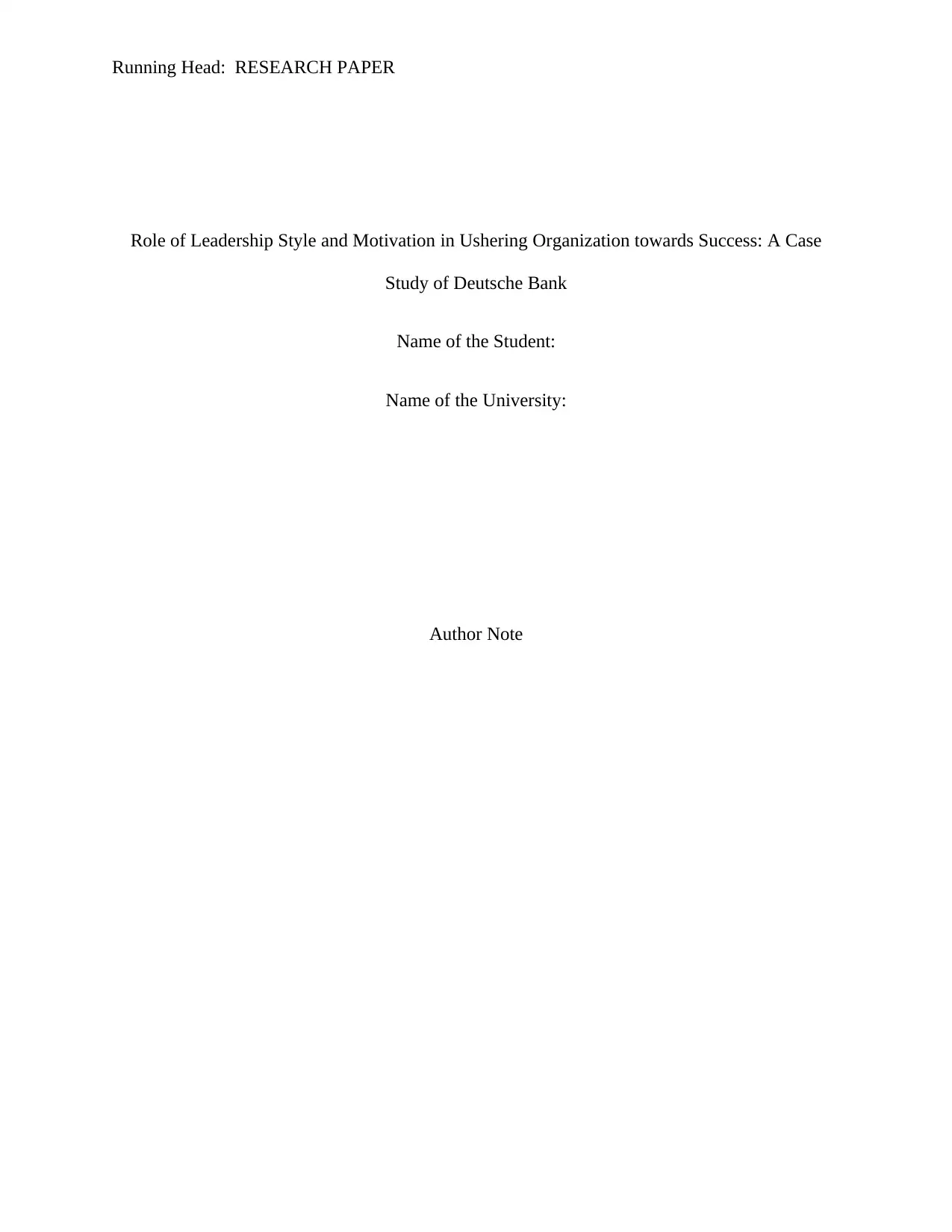
Running Head: RESEARCH PAPER
Role of Leadership Style and Motivation in Ushering Organization towards Success: A Case
Study of Deutsche Bank
Name of the Student:
Name of the University:
Author Note
Role of Leadership Style and Motivation in Ushering Organization towards Success: A Case
Study of Deutsche Bank
Name of the Student:
Name of the University:
Author Note
Paraphrase This Document
Need a fresh take? Get an instant paraphrase of this document with our AI Paraphraser
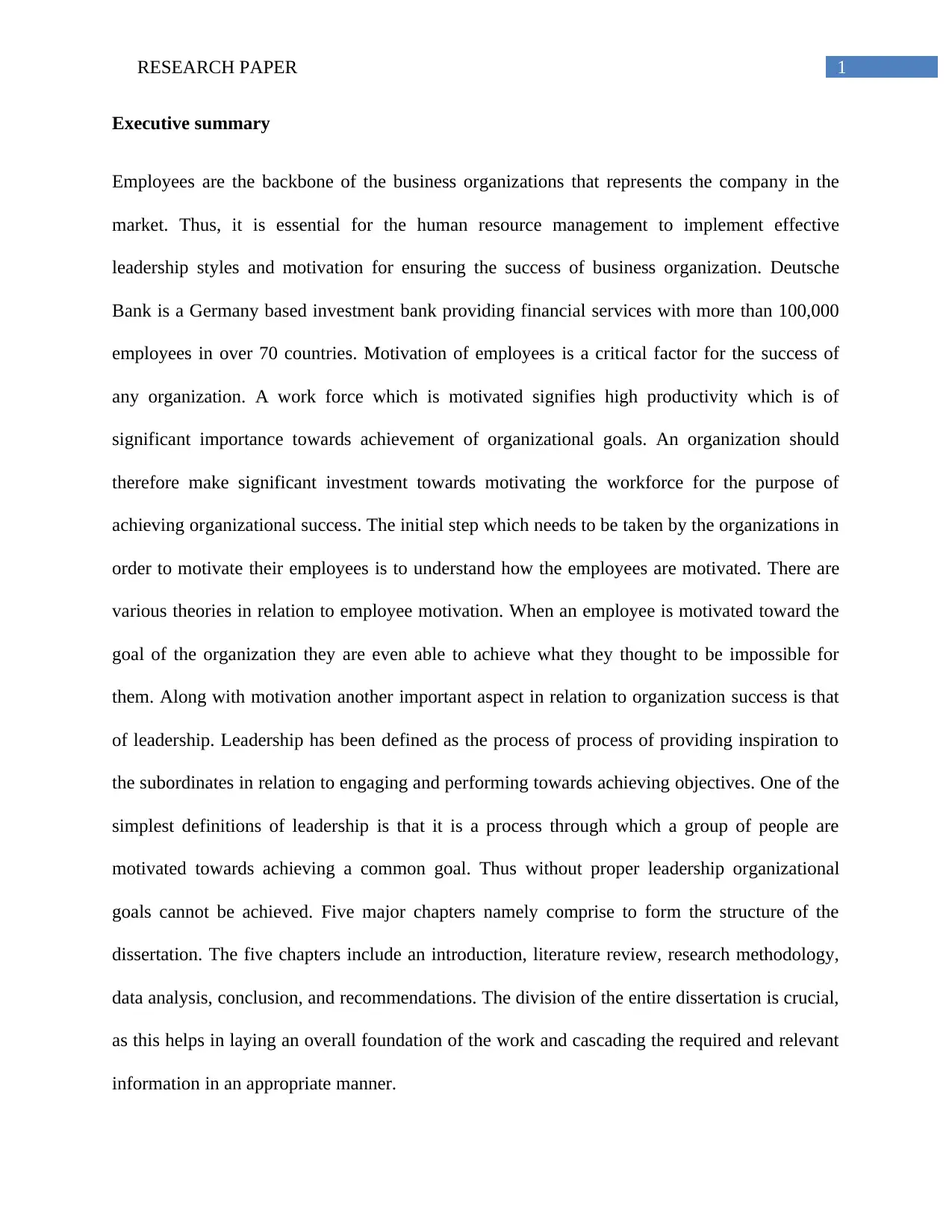
1RESEARCH PAPER
Executive summary
Employees are the backbone of the business organizations that represents the company in the
market. Thus, it is essential for the human resource management to implement effective
leadership styles and motivation for ensuring the success of business organization. Deutsche
Bank is a Germany based investment bank providing financial services with more than 100,000
employees in over 70 countries. Motivation of employees is a critical factor for the success of
any organization. A work force which is motivated signifies high productivity which is of
significant importance towards achievement of organizational goals. An organization should
therefore make significant investment towards motivating the workforce for the purpose of
achieving organizational success. The initial step which needs to be taken by the organizations in
order to motivate their employees is to understand how the employees are motivated. There are
various theories in relation to employee motivation. When an employee is motivated toward the
goal of the organization they are even able to achieve what they thought to be impossible for
them. Along with motivation another important aspect in relation to organization success is that
of leadership. Leadership has been defined as the process of process of providing inspiration to
the subordinates in relation to engaging and performing towards achieving objectives. One of the
simplest definitions of leadership is that it is a process through which a group of people are
motivated towards achieving a common goal. Thus without proper leadership organizational
goals cannot be achieved. Five major chapters namely comprise to form the structure of the
dissertation. The five chapters include an introduction, literature review, research methodology,
data analysis, conclusion, and recommendations. The division of the entire dissertation is crucial,
as this helps in laying an overall foundation of the work and cascading the required and relevant
information in an appropriate manner.
Executive summary
Employees are the backbone of the business organizations that represents the company in the
market. Thus, it is essential for the human resource management to implement effective
leadership styles and motivation for ensuring the success of business organization. Deutsche
Bank is a Germany based investment bank providing financial services with more than 100,000
employees in over 70 countries. Motivation of employees is a critical factor for the success of
any organization. A work force which is motivated signifies high productivity which is of
significant importance towards achievement of organizational goals. An organization should
therefore make significant investment towards motivating the workforce for the purpose of
achieving organizational success. The initial step which needs to be taken by the organizations in
order to motivate their employees is to understand how the employees are motivated. There are
various theories in relation to employee motivation. When an employee is motivated toward the
goal of the organization they are even able to achieve what they thought to be impossible for
them. Along with motivation another important aspect in relation to organization success is that
of leadership. Leadership has been defined as the process of process of providing inspiration to
the subordinates in relation to engaging and performing towards achieving objectives. One of the
simplest definitions of leadership is that it is a process through which a group of people are
motivated towards achieving a common goal. Thus without proper leadership organizational
goals cannot be achieved. Five major chapters namely comprise to form the structure of the
dissertation. The five chapters include an introduction, literature review, research methodology,
data analysis, conclusion, and recommendations. The division of the entire dissertation is crucial,
as this helps in laying an overall foundation of the work and cascading the required and relevant
information in an appropriate manner.
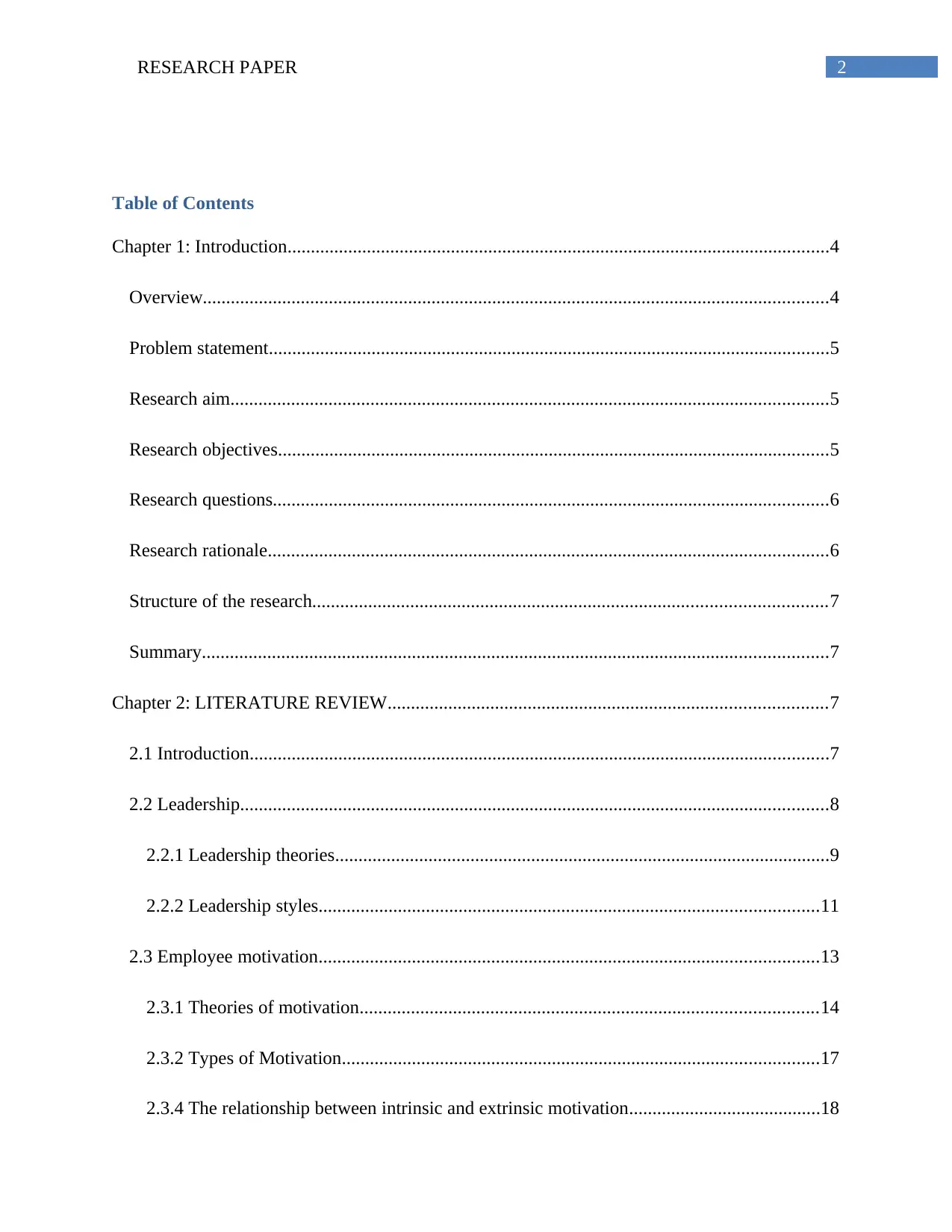
2RESEARCH PAPER
Table of Contents
Chapter 1: Introduction....................................................................................................................4
Overview......................................................................................................................................4
Problem statement........................................................................................................................5
Research aim................................................................................................................................5
Research objectives......................................................................................................................5
Research questions.......................................................................................................................6
Research rationale........................................................................................................................6
Structure of the research..............................................................................................................7
Summary......................................................................................................................................7
Chapter 2: LITERATURE REVIEW..............................................................................................7
2.1 Introduction............................................................................................................................7
2.2 Leadership..............................................................................................................................8
2.2.1 Leadership theories..........................................................................................................9
2.2.2 Leadership styles...........................................................................................................11
2.3 Employee motivation...........................................................................................................13
2.3.1 Theories of motivation..................................................................................................14
2.3.2 Types of Motivation......................................................................................................17
2.3.4 The relationship between intrinsic and extrinsic motivation.........................................18
Table of Contents
Chapter 1: Introduction....................................................................................................................4
Overview......................................................................................................................................4
Problem statement........................................................................................................................5
Research aim................................................................................................................................5
Research objectives......................................................................................................................5
Research questions.......................................................................................................................6
Research rationale........................................................................................................................6
Structure of the research..............................................................................................................7
Summary......................................................................................................................................7
Chapter 2: LITERATURE REVIEW..............................................................................................7
2.1 Introduction............................................................................................................................7
2.2 Leadership..............................................................................................................................8
2.2.1 Leadership theories..........................................................................................................9
2.2.2 Leadership styles...........................................................................................................11
2.3 Employee motivation...........................................................................................................13
2.3.1 Theories of motivation..................................................................................................14
2.3.2 Types of Motivation......................................................................................................17
2.3.4 The relationship between intrinsic and extrinsic motivation.........................................18
⊘ This is a preview!⊘
Do you want full access?
Subscribe today to unlock all pages.

Trusted by 1+ million students worldwide
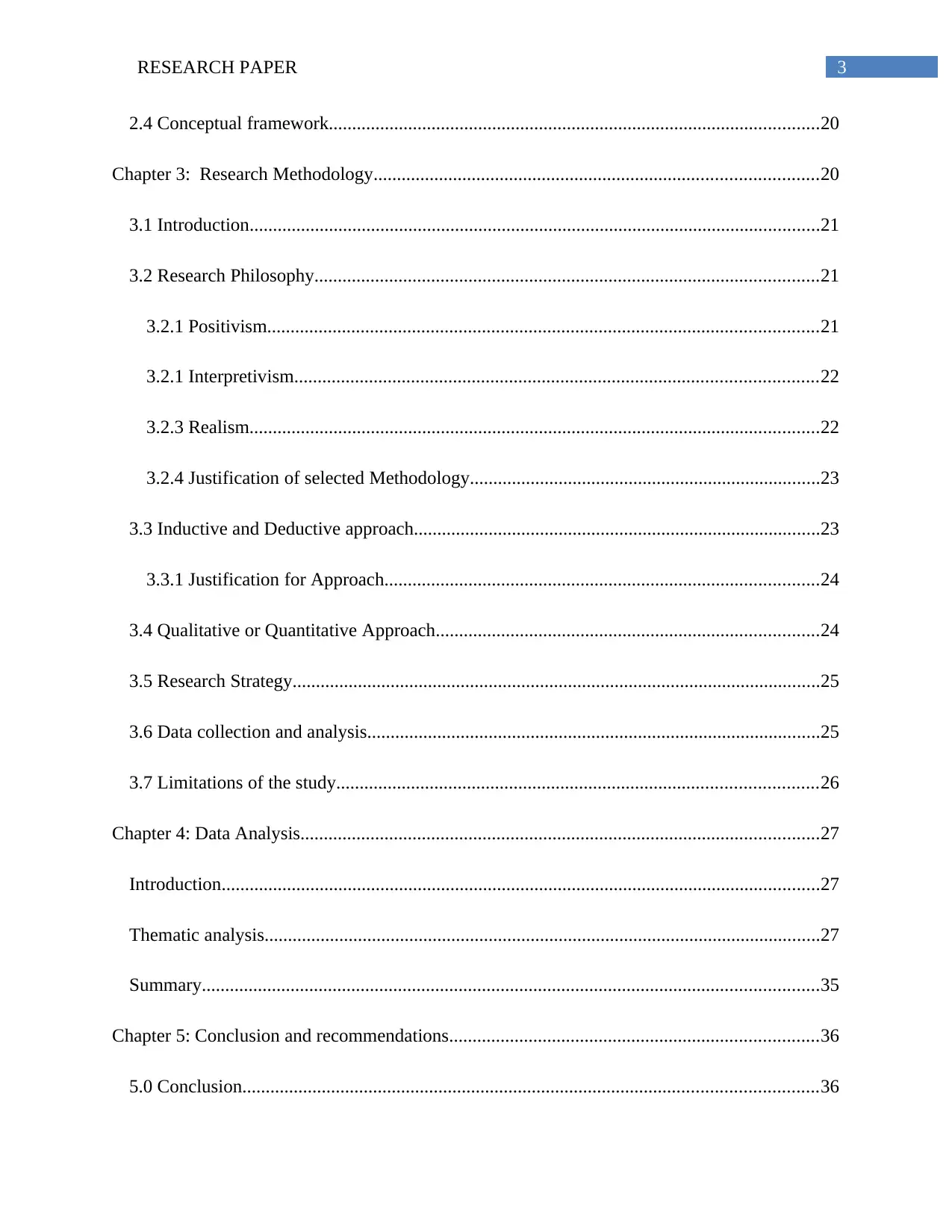
3RESEARCH PAPER
2.4 Conceptual framework.........................................................................................................20
Chapter 3: Research Methodology...............................................................................................20
3.1 Introduction..........................................................................................................................21
3.2 Research Philosophy............................................................................................................21
3.2.1 Positivism......................................................................................................................21
3.2.1 Interpretivism................................................................................................................22
3.2.3 Realism..........................................................................................................................22
3.2.4 Justification of selected Methodology...........................................................................23
3.3 Inductive and Deductive approach.......................................................................................23
3.3.1 Justification for Approach.............................................................................................24
3.4 Qualitative or Quantitative Approach..................................................................................24
3.5 Research Strategy.................................................................................................................25
3.6 Data collection and analysis.................................................................................................25
3.7 Limitations of the study.......................................................................................................26
Chapter 4: Data Analysis...............................................................................................................27
Introduction................................................................................................................................27
Thematic analysis.......................................................................................................................27
Summary....................................................................................................................................35
Chapter 5: Conclusion and recommendations...............................................................................36
5.0 Conclusion...........................................................................................................................36
2.4 Conceptual framework.........................................................................................................20
Chapter 3: Research Methodology...............................................................................................20
3.1 Introduction..........................................................................................................................21
3.2 Research Philosophy............................................................................................................21
3.2.1 Positivism......................................................................................................................21
3.2.1 Interpretivism................................................................................................................22
3.2.3 Realism..........................................................................................................................22
3.2.4 Justification of selected Methodology...........................................................................23
3.3 Inductive and Deductive approach.......................................................................................23
3.3.1 Justification for Approach.............................................................................................24
3.4 Qualitative or Quantitative Approach..................................................................................24
3.5 Research Strategy.................................................................................................................25
3.6 Data collection and analysis.................................................................................................25
3.7 Limitations of the study.......................................................................................................26
Chapter 4: Data Analysis...............................................................................................................27
Introduction................................................................................................................................27
Thematic analysis.......................................................................................................................27
Summary....................................................................................................................................35
Chapter 5: Conclusion and recommendations...............................................................................36
5.0 Conclusion...........................................................................................................................36
Paraphrase This Document
Need a fresh take? Get an instant paraphrase of this document with our AI Paraphraser
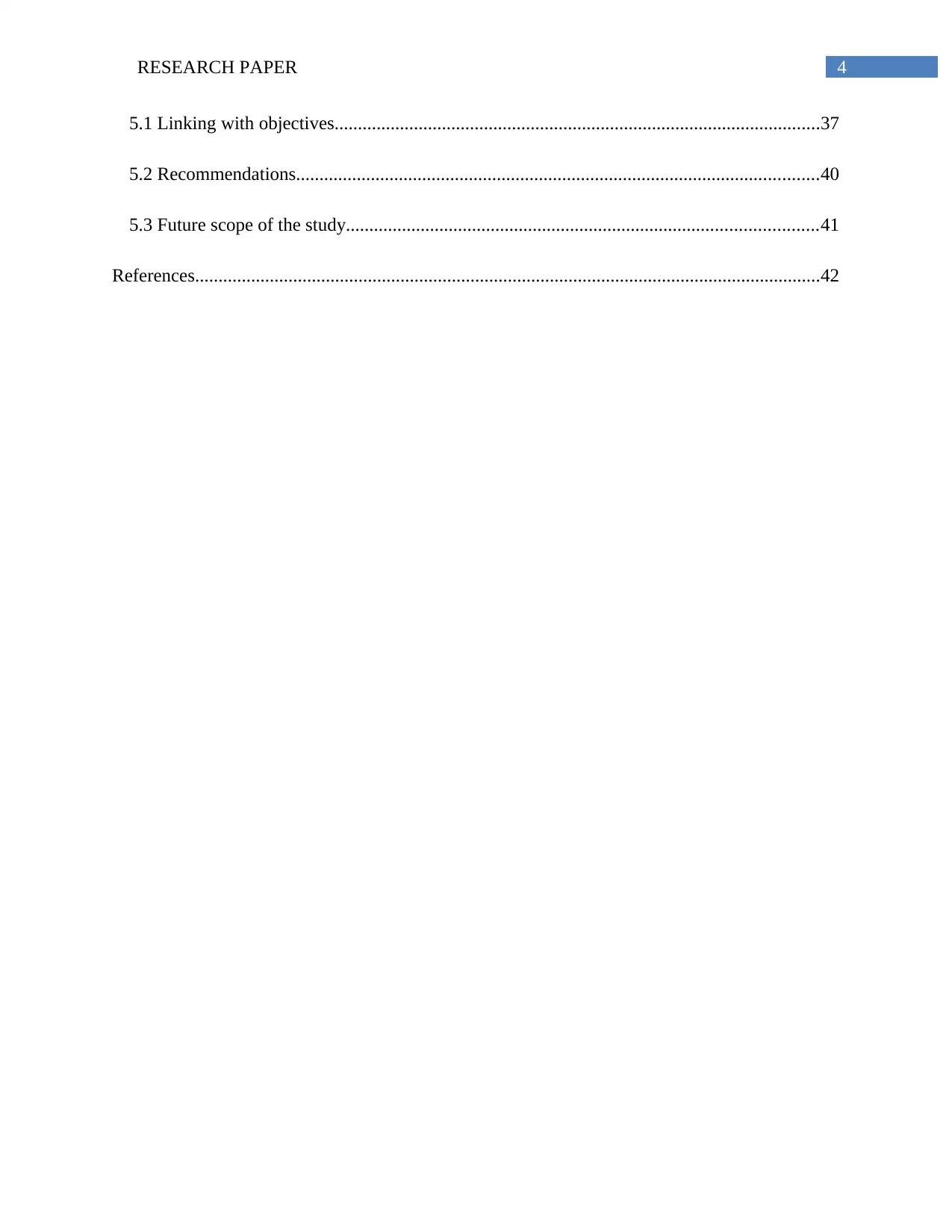
4RESEARCH PAPER
5.1 Linking with objectives........................................................................................................37
5.2 Recommendations................................................................................................................40
5.3 Future scope of the study.....................................................................................................41
References......................................................................................................................................42
5.1 Linking with objectives........................................................................................................37
5.2 Recommendations................................................................................................................40
5.3 Future scope of the study.....................................................................................................41
References......................................................................................................................................42
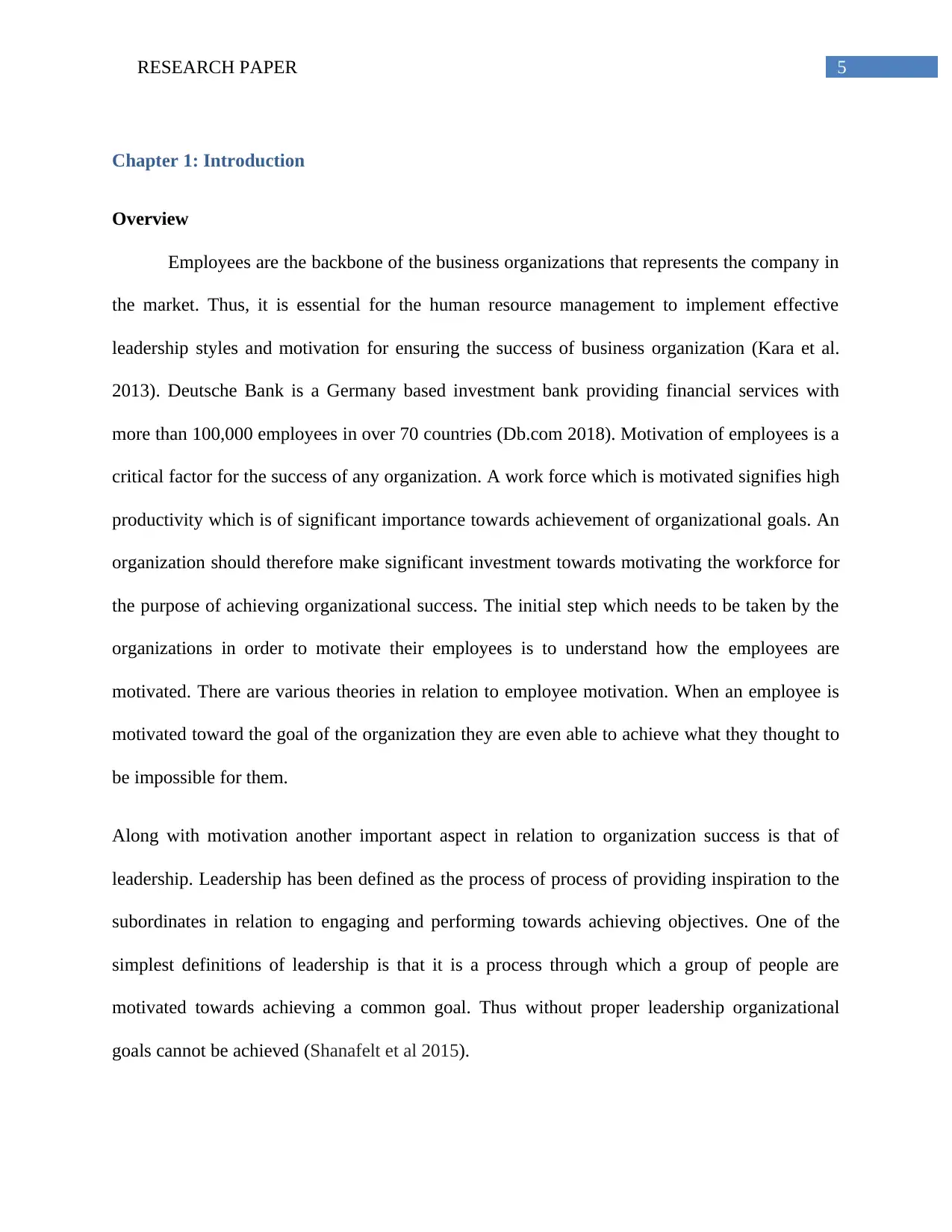
5RESEARCH PAPER
Chapter 1: Introduction
Overview
Employees are the backbone of the business organizations that represents the company in
the market. Thus, it is essential for the human resource management to implement effective
leadership styles and motivation for ensuring the success of business organization (Kara et al.
2013). Deutsche Bank is a Germany based investment bank providing financial services with
more than 100,000 employees in over 70 countries (Db.com 2018). Motivation of employees is a
critical factor for the success of any organization. A work force which is motivated signifies high
productivity which is of significant importance towards achievement of organizational goals. An
organization should therefore make significant investment towards motivating the workforce for
the purpose of achieving organizational success. The initial step which needs to be taken by the
organizations in order to motivate their employees is to understand how the employees are
motivated. There are various theories in relation to employee motivation. When an employee is
motivated toward the goal of the organization they are even able to achieve what they thought to
be impossible for them.
Along with motivation another important aspect in relation to organization success is that of
leadership. Leadership has been defined as the process of process of providing inspiration to the
subordinates in relation to engaging and performing towards achieving objectives. One of the
simplest definitions of leadership is that it is a process through which a group of people are
motivated towards achieving a common goal. Thus without proper leadership organizational
goals cannot be achieved (Shanafelt et al 2015).
Chapter 1: Introduction
Overview
Employees are the backbone of the business organizations that represents the company in
the market. Thus, it is essential for the human resource management to implement effective
leadership styles and motivation for ensuring the success of business organization (Kara et al.
2013). Deutsche Bank is a Germany based investment bank providing financial services with
more than 100,000 employees in over 70 countries (Db.com 2018). Motivation of employees is a
critical factor for the success of any organization. A work force which is motivated signifies high
productivity which is of significant importance towards achievement of organizational goals. An
organization should therefore make significant investment towards motivating the workforce for
the purpose of achieving organizational success. The initial step which needs to be taken by the
organizations in order to motivate their employees is to understand how the employees are
motivated. There are various theories in relation to employee motivation. When an employee is
motivated toward the goal of the organization they are even able to achieve what they thought to
be impossible for them.
Along with motivation another important aspect in relation to organization success is that of
leadership. Leadership has been defined as the process of process of providing inspiration to the
subordinates in relation to engaging and performing towards achieving objectives. One of the
simplest definitions of leadership is that it is a process through which a group of people are
motivated towards achieving a common goal. Thus without proper leadership organizational
goals cannot be achieved (Shanafelt et al 2015).
⊘ This is a preview!⊘
Do you want full access?
Subscribe today to unlock all pages.

Trusted by 1+ million students worldwide
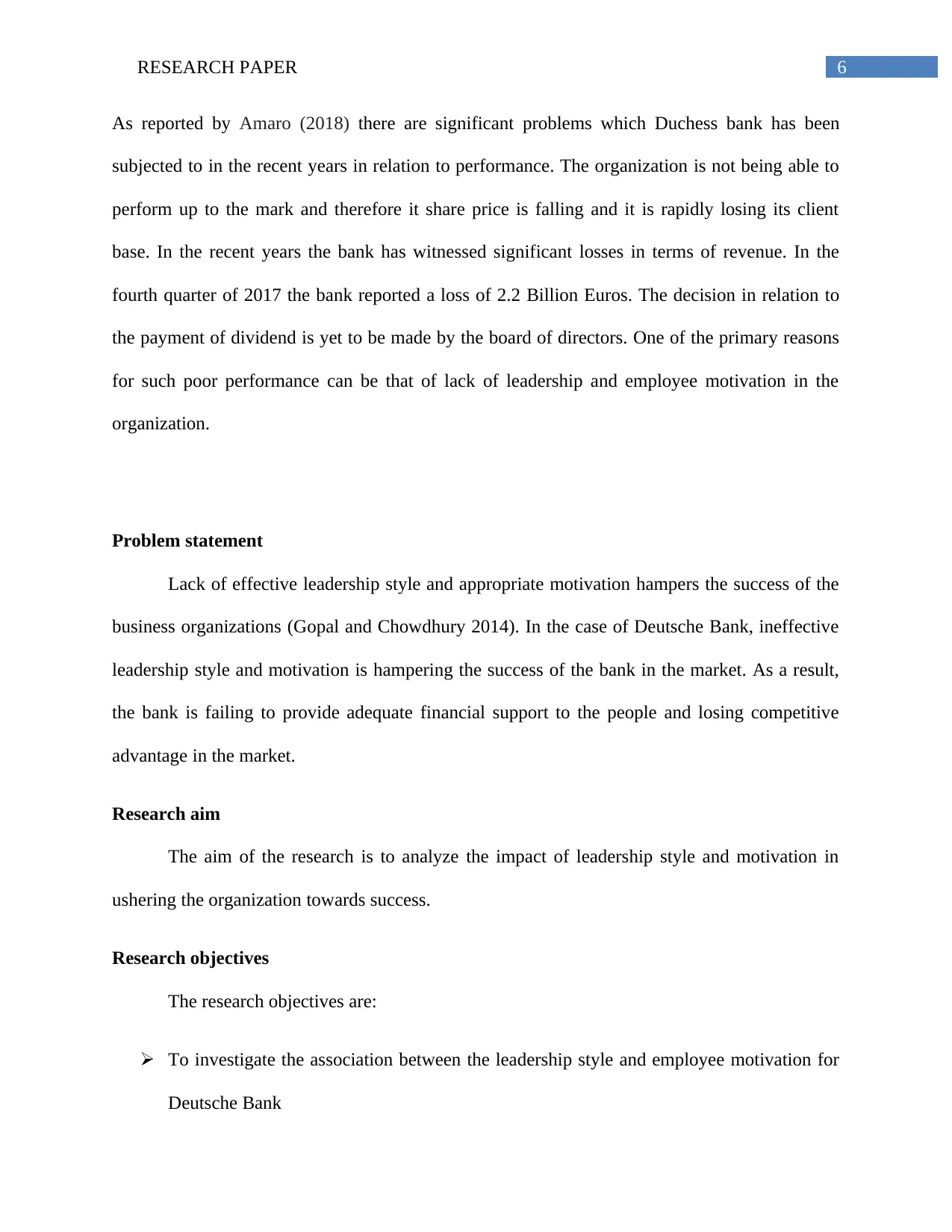
6RESEARCH PAPER
As reported by Amaro (2018) there are significant problems which Duchess bank has been
subjected to in the recent years in relation to performance. The organization is not being able to
perform up to the mark and therefore it share price is falling and it is rapidly losing its client
base. In the recent years the bank has witnessed significant losses in terms of revenue. In the
fourth quarter of 2017 the bank reported a loss of 2.2 Billion Euros. The decision in relation to
the payment of dividend is yet to be made by the board of directors. One of the primary reasons
for such poor performance can be that of lack of leadership and employee motivation in the
organization.
Problem statement
Lack of effective leadership style and appropriate motivation hampers the success of the
business organizations (Gopal and Chowdhury 2014). In the case of Deutsche Bank, ineffective
leadership style and motivation is hampering the success of the bank in the market. As a result,
the bank is failing to provide adequate financial support to the people and losing competitive
advantage in the market.
Research aim
The aim of the research is to analyze the impact of leadership style and motivation in
ushering the organization towards success.
Research objectives
The research objectives are:
To investigate the association between the leadership style and employee motivation for
Deutsche Bank
As reported by Amaro (2018) there are significant problems which Duchess bank has been
subjected to in the recent years in relation to performance. The organization is not being able to
perform up to the mark and therefore it share price is falling and it is rapidly losing its client
base. In the recent years the bank has witnessed significant losses in terms of revenue. In the
fourth quarter of 2017 the bank reported a loss of 2.2 Billion Euros. The decision in relation to
the payment of dividend is yet to be made by the board of directors. One of the primary reasons
for such poor performance can be that of lack of leadership and employee motivation in the
organization.
Problem statement
Lack of effective leadership style and appropriate motivation hampers the success of the
business organizations (Gopal and Chowdhury 2014). In the case of Deutsche Bank, ineffective
leadership style and motivation is hampering the success of the bank in the market. As a result,
the bank is failing to provide adequate financial support to the people and losing competitive
advantage in the market.
Research aim
The aim of the research is to analyze the impact of leadership style and motivation in
ushering the organization towards success.
Research objectives
The research objectives are:
To investigate the association between the leadership style and employee motivation for
Deutsche Bank
Paraphrase This Document
Need a fresh take? Get an instant paraphrase of this document with our AI Paraphraser
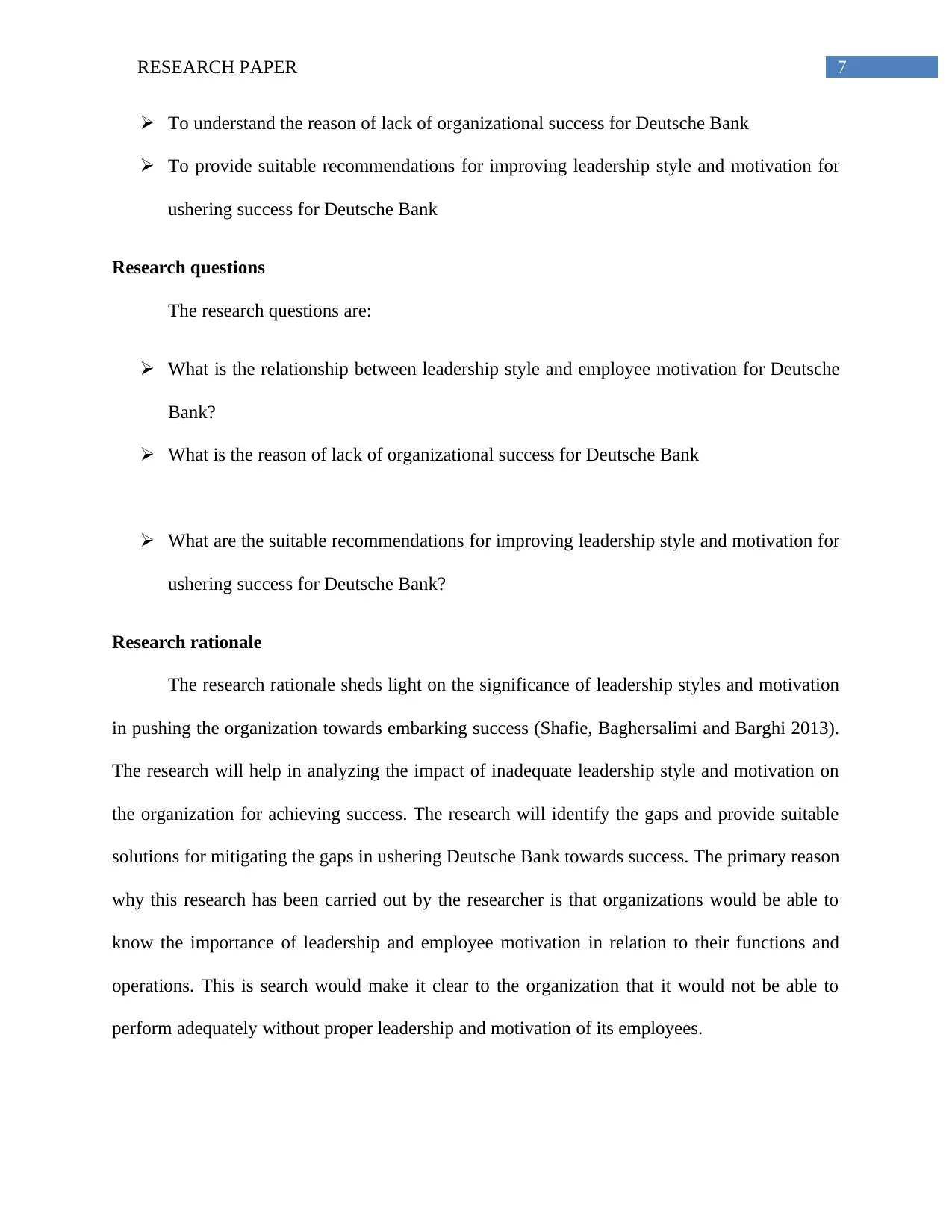
7RESEARCH PAPER
To understand the reason of lack of organizational success for Deutsche Bank
To provide suitable recommendations for improving leadership style and motivation for
ushering success for Deutsche Bank
Research questions
The research questions are:
What is the relationship between leadership style and employee motivation for Deutsche
Bank?
What is the reason of lack of organizational success for Deutsche Bank
What are the suitable recommendations for improving leadership style and motivation for
ushering success for Deutsche Bank?
Research rationale
The research rationale sheds light on the significance of leadership styles and motivation
in pushing the organization towards embarking success (Shafie, Baghersalimi and Barghi 2013).
The research will help in analyzing the impact of inadequate leadership style and motivation on
the organization for achieving success. The research will identify the gaps and provide suitable
solutions for mitigating the gaps in ushering Deutsche Bank towards success. The primary reason
why this research has been carried out by the researcher is that organizations would be able to
know the importance of leadership and employee motivation in relation to their functions and
operations. This is search would make it clear to the organization that it would not be able to
perform adequately without proper leadership and motivation of its employees.
To understand the reason of lack of organizational success for Deutsche Bank
To provide suitable recommendations for improving leadership style and motivation for
ushering success for Deutsche Bank
Research questions
The research questions are:
What is the relationship between leadership style and employee motivation for Deutsche
Bank?
What is the reason of lack of organizational success for Deutsche Bank
What are the suitable recommendations for improving leadership style and motivation for
ushering success for Deutsche Bank?
Research rationale
The research rationale sheds light on the significance of leadership styles and motivation
in pushing the organization towards embarking success (Shafie, Baghersalimi and Barghi 2013).
The research will help in analyzing the impact of inadequate leadership style and motivation on
the organization for achieving success. The research will identify the gaps and provide suitable
solutions for mitigating the gaps in ushering Deutsche Bank towards success. The primary reason
why this research has been carried out by the researcher is that organizations would be able to
know the importance of leadership and employee motivation in relation to their functions and
operations. This is search would make it clear to the organization that it would not be able to
perform adequately without proper leadership and motivation of its employees.
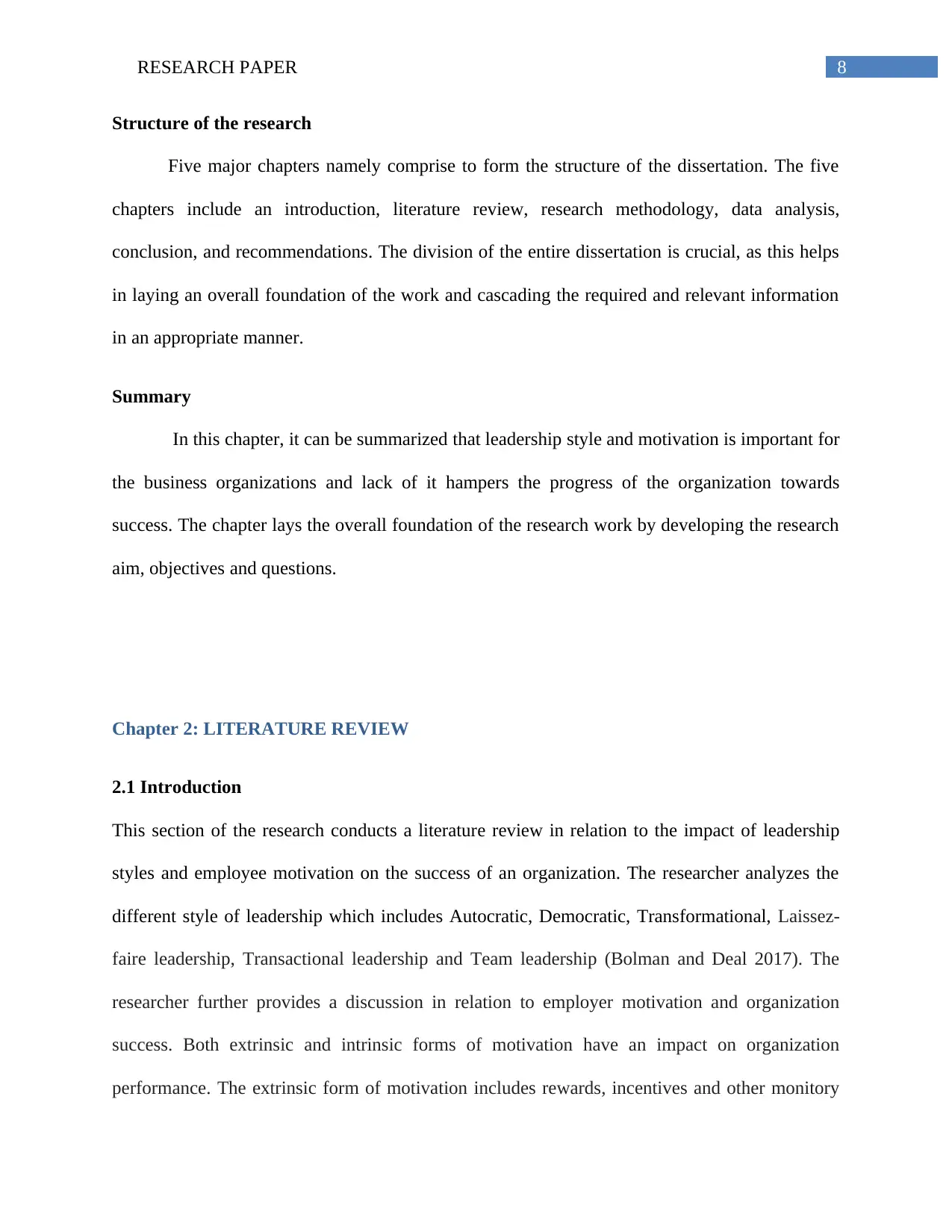
8RESEARCH PAPER
Structure of the research
Five major chapters namely comprise to form the structure of the dissertation. The five
chapters include an introduction, literature review, research methodology, data analysis,
conclusion, and recommendations. The division of the entire dissertation is crucial, as this helps
in laying an overall foundation of the work and cascading the required and relevant information
in an appropriate manner.
Summary
In this chapter, it can be summarized that leadership style and motivation is important for
the business organizations and lack of it hampers the progress of the organization towards
success. The chapter lays the overall foundation of the research work by developing the research
aim, objectives and questions.
Chapter 2: LITERATURE REVIEW
2.1 Introduction
This section of the research conducts a literature review in relation to the impact of leadership
styles and employee motivation on the success of an organization. The researcher analyzes the
different style of leadership which includes Autocratic, Democratic, Transformational, Laissez-
faire leadership, Transactional leadership and Team leadership (Bolman and Deal 2017). The
researcher further provides a discussion in relation to employer motivation and organization
success. Both extrinsic and intrinsic forms of motivation have an impact on organization
performance. The extrinsic form of motivation includes rewards, incentives and other monitory
Structure of the research
Five major chapters namely comprise to form the structure of the dissertation. The five
chapters include an introduction, literature review, research methodology, data analysis,
conclusion, and recommendations. The division of the entire dissertation is crucial, as this helps
in laying an overall foundation of the work and cascading the required and relevant information
in an appropriate manner.
Summary
In this chapter, it can be summarized that leadership style and motivation is important for
the business organizations and lack of it hampers the progress of the organization towards
success. The chapter lays the overall foundation of the research work by developing the research
aim, objectives and questions.
Chapter 2: LITERATURE REVIEW
2.1 Introduction
This section of the research conducts a literature review in relation to the impact of leadership
styles and employee motivation on the success of an organization. The researcher analyzes the
different style of leadership which includes Autocratic, Democratic, Transformational, Laissez-
faire leadership, Transactional leadership and Team leadership (Bolman and Deal 2017). The
researcher further provides a discussion in relation to employer motivation and organization
success. Both extrinsic and intrinsic forms of motivation have an impact on organization
performance. The extrinsic form of motivation includes rewards, incentives and other monitory
⊘ This is a preview!⊘
Do you want full access?
Subscribe today to unlock all pages.

Trusted by 1+ million students worldwide
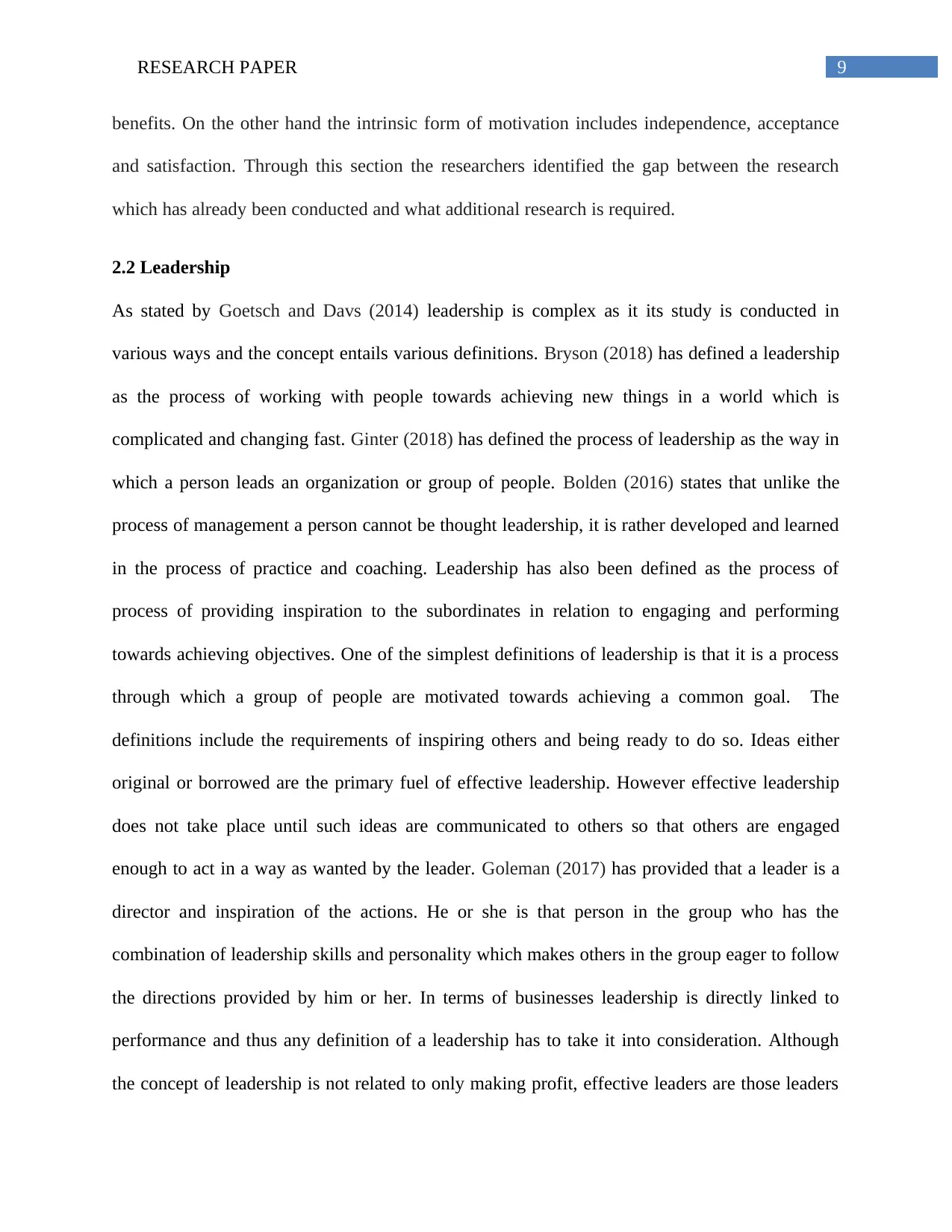
9RESEARCH PAPER
benefits. On the other hand the intrinsic form of motivation includes independence, acceptance
and satisfaction. Through this section the researchers identified the gap between the research
which has already been conducted and what additional research is required.
2.2 Leadership
As stated by Goetsch and Davs (2014) leadership is complex as it its study is conducted in
various ways and the concept entails various definitions. Bryson (2018) has defined a leadership
as the process of working with people towards achieving new things in a world which is
complicated and changing fast. Ginter (2018) has defined the process of leadership as the way in
which a person leads an organization or group of people. Bolden (2016) states that unlike the
process of management a person cannot be thought leadership, it is rather developed and learned
in the process of practice and coaching. Leadership has also been defined as the process of
process of providing inspiration to the subordinates in relation to engaging and performing
towards achieving objectives. One of the simplest definitions of leadership is that it is a process
through which a group of people are motivated towards achieving a common goal. The
definitions include the requirements of inspiring others and being ready to do so. Ideas either
original or borrowed are the primary fuel of effective leadership. However effective leadership
does not take place until such ideas are communicated to others so that others are engaged
enough to act in a way as wanted by the leader. Goleman (2017) has provided that a leader is a
director and inspiration of the actions. He or she is that person in the group who has the
combination of leadership skills and personality which makes others in the group eager to follow
the directions provided by him or her. In terms of businesses leadership is directly linked to
performance and thus any definition of a leadership has to take it into consideration. Although
the concept of leadership is not related to only making profit, effective leaders are those leaders
benefits. On the other hand the intrinsic form of motivation includes independence, acceptance
and satisfaction. Through this section the researchers identified the gap between the research
which has already been conducted and what additional research is required.
2.2 Leadership
As stated by Goetsch and Davs (2014) leadership is complex as it its study is conducted in
various ways and the concept entails various definitions. Bryson (2018) has defined a leadership
as the process of working with people towards achieving new things in a world which is
complicated and changing fast. Ginter (2018) has defined the process of leadership as the way in
which a person leads an organization or group of people. Bolden (2016) states that unlike the
process of management a person cannot be thought leadership, it is rather developed and learned
in the process of practice and coaching. Leadership has also been defined as the process of
process of providing inspiration to the subordinates in relation to engaging and performing
towards achieving objectives. One of the simplest definitions of leadership is that it is a process
through which a group of people are motivated towards achieving a common goal. The
definitions include the requirements of inspiring others and being ready to do so. Ideas either
original or borrowed are the primary fuel of effective leadership. However effective leadership
does not take place until such ideas are communicated to others so that others are engaged
enough to act in a way as wanted by the leader. Goleman (2017) has provided that a leader is a
director and inspiration of the actions. He or she is that person in the group who has the
combination of leadership skills and personality which makes others in the group eager to follow
the directions provided by him or her. In terms of businesses leadership is directly linked to
performance and thus any definition of a leadership has to take it into consideration. Although
the concept of leadership is not related to only making profit, effective leaders are those leaders
Paraphrase This Document
Need a fresh take? Get an instant paraphrase of this document with our AI Paraphraser
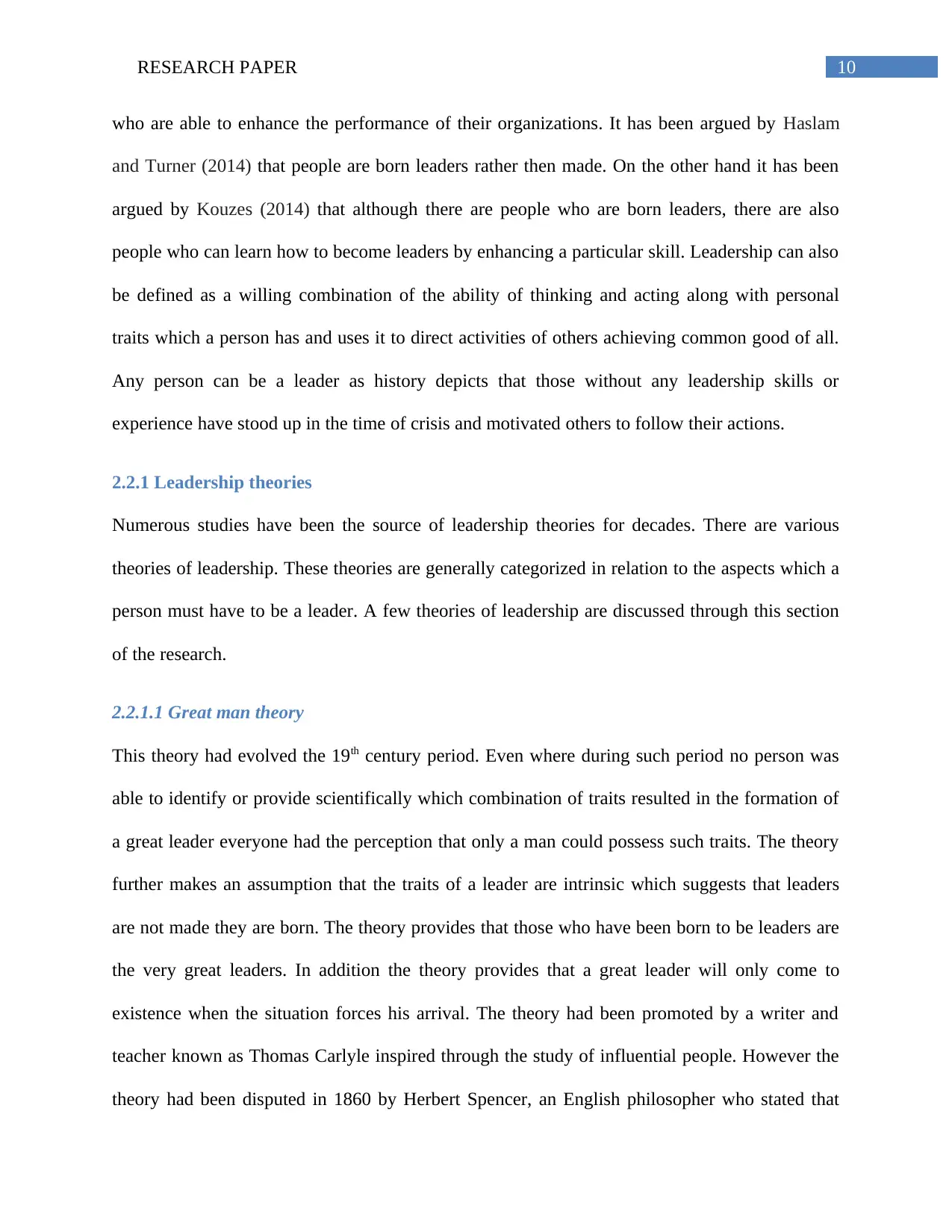
10RESEARCH PAPER
who are able to enhance the performance of their organizations. It has been argued by Haslam
and Turner (2014) that people are born leaders rather then made. On the other hand it has been
argued by Kouzes (2014) that although there are people who are born leaders, there are also
people who can learn how to become leaders by enhancing a particular skill. Leadership can also
be defined as a willing combination of the ability of thinking and acting along with personal
traits which a person has and uses it to direct activities of others achieving common good of all.
Any person can be a leader as history depicts that those without any leadership skills or
experience have stood up in the time of crisis and motivated others to follow their actions.
2.2.1 Leadership theories
Numerous studies have been the source of leadership theories for decades. There are various
theories of leadership. These theories are generally categorized in relation to the aspects which a
person must have to be a leader. A few theories of leadership are discussed through this section
of the research.
2.2.1.1 Great man theory
This theory had evolved the 19th century period. Even where during such period no person was
able to identify or provide scientifically which combination of traits resulted in the formation of
a great leader everyone had the perception that only a man could possess such traits. The theory
further makes an assumption that the traits of a leader are intrinsic which suggests that leaders
are not made they are born. The theory provides that those who have been born to be leaders are
the very great leaders. In addition the theory provides that a great leader will only come to
existence when the situation forces his arrival. The theory had been promoted by a writer and
teacher known as Thomas Carlyle inspired through the study of influential people. However the
theory had been disputed in 1860 by Herbert Spencer, an English philosopher who stated that
who are able to enhance the performance of their organizations. It has been argued by Haslam
and Turner (2014) that people are born leaders rather then made. On the other hand it has been
argued by Kouzes (2014) that although there are people who are born leaders, there are also
people who can learn how to become leaders by enhancing a particular skill. Leadership can also
be defined as a willing combination of the ability of thinking and acting along with personal
traits which a person has and uses it to direct activities of others achieving common good of all.
Any person can be a leader as history depicts that those without any leadership skills or
experience have stood up in the time of crisis and motivated others to follow their actions.
2.2.1 Leadership theories
Numerous studies have been the source of leadership theories for decades. There are various
theories of leadership. These theories are generally categorized in relation to the aspects which a
person must have to be a leader. A few theories of leadership are discussed through this section
of the research.
2.2.1.1 Great man theory
This theory had evolved the 19th century period. Even where during such period no person was
able to identify or provide scientifically which combination of traits resulted in the formation of
a great leader everyone had the perception that only a man could possess such traits. The theory
further makes an assumption that the traits of a leader are intrinsic which suggests that leaders
are not made they are born. The theory provides that those who have been born to be leaders are
the very great leaders. In addition the theory provides that a great leader will only come to
existence when the situation forces his arrival. The theory had been promoted by a writer and
teacher known as Thomas Carlyle inspired through the study of influential people. However the
theory had been disputed in 1860 by Herbert Spencer, an English philosopher who stated that
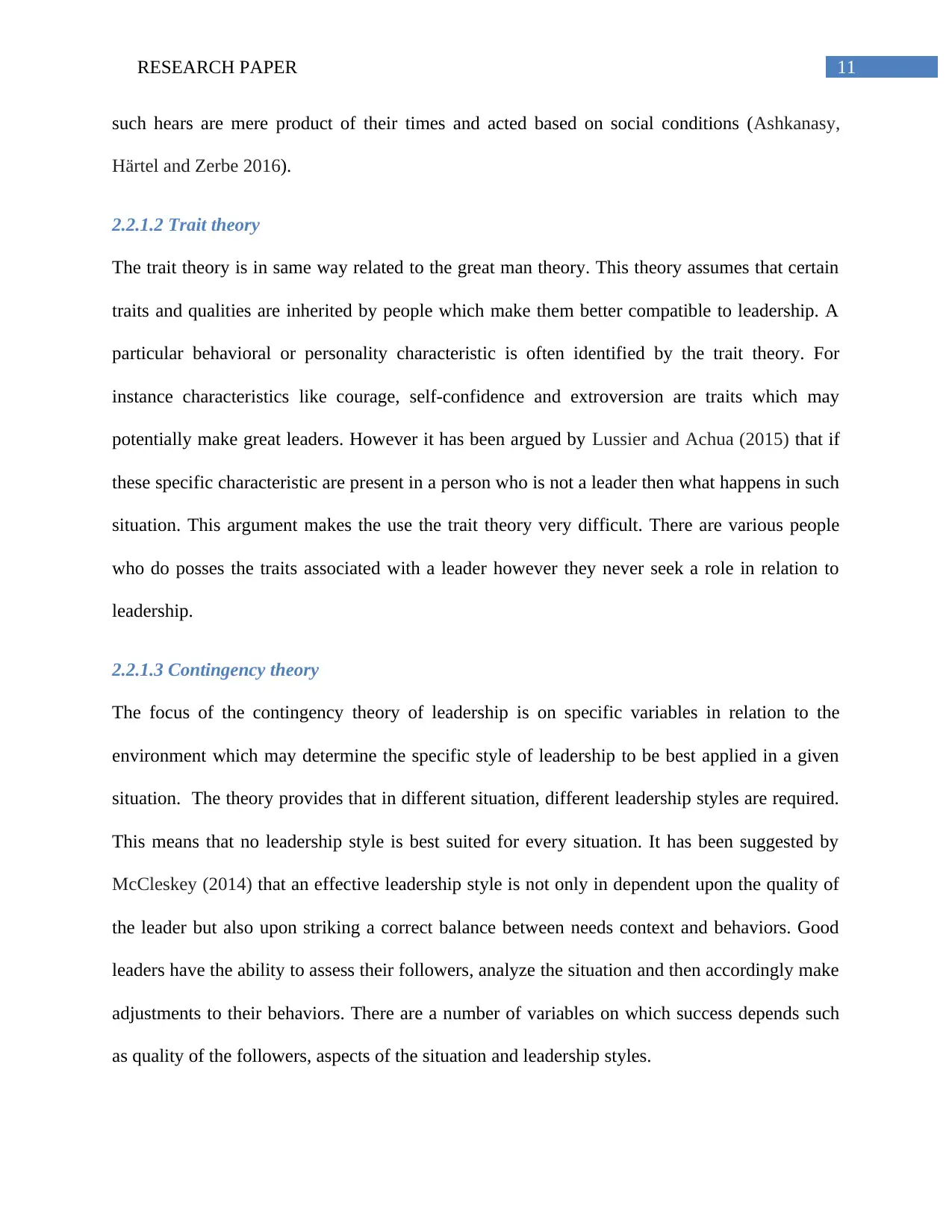
11RESEARCH PAPER
such hears are mere product of their times and acted based on social conditions (Ashkanasy,
Härtel and Zerbe 2016).
2.2.1.2 Trait theory
The trait theory is in same way related to the great man theory. This theory assumes that certain
traits and qualities are inherited by people which make them better compatible to leadership. A
particular behavioral or personality characteristic is often identified by the trait theory. For
instance characteristics like courage, self-confidence and extroversion are traits which may
potentially make great leaders. However it has been argued by Lussier and Achua (2015) that if
these specific characteristic are present in a person who is not a leader then what happens in such
situation. This argument makes the use the trait theory very difficult. There are various people
who do posses the traits associated with a leader however they never seek a role in relation to
leadership.
2.2.1.3 Contingency theory
The focus of the contingency theory of leadership is on specific variables in relation to the
environment which may determine the specific style of leadership to be best applied in a given
situation. The theory provides that in different situation, different leadership styles are required.
This means that no leadership style is best suited for every situation. It has been suggested by
McCleskey (2014) that an effective leadership style is not only in dependent upon the quality of
the leader but also upon striking a correct balance between needs context and behaviors. Good
leaders have the ability to assess their followers, analyze the situation and then accordingly make
adjustments to their behaviors. There are a number of variables on which success depends such
as quality of the followers, aspects of the situation and leadership styles.
such hears are mere product of their times and acted based on social conditions (Ashkanasy,
Härtel and Zerbe 2016).
2.2.1.2 Trait theory
The trait theory is in same way related to the great man theory. This theory assumes that certain
traits and qualities are inherited by people which make them better compatible to leadership. A
particular behavioral or personality characteristic is often identified by the trait theory. For
instance characteristics like courage, self-confidence and extroversion are traits which may
potentially make great leaders. However it has been argued by Lussier and Achua (2015) that if
these specific characteristic are present in a person who is not a leader then what happens in such
situation. This argument makes the use the trait theory very difficult. There are various people
who do posses the traits associated with a leader however they never seek a role in relation to
leadership.
2.2.1.3 Contingency theory
The focus of the contingency theory of leadership is on specific variables in relation to the
environment which may determine the specific style of leadership to be best applied in a given
situation. The theory provides that in different situation, different leadership styles are required.
This means that no leadership style is best suited for every situation. It has been suggested by
McCleskey (2014) that an effective leadership style is not only in dependent upon the quality of
the leader but also upon striking a correct balance between needs context and behaviors. Good
leaders have the ability to assess their followers, analyze the situation and then accordingly make
adjustments to their behaviors. There are a number of variables on which success depends such
as quality of the followers, aspects of the situation and leadership styles.
⊘ This is a preview!⊘
Do you want full access?
Subscribe today to unlock all pages.

Trusted by 1+ million students worldwide
1 out of 54
Related Documents
Your All-in-One AI-Powered Toolkit for Academic Success.
+13062052269
info@desklib.com
Available 24*7 on WhatsApp / Email
![[object Object]](/_next/static/media/star-bottom.7253800d.svg)
Unlock your academic potential
Copyright © 2020–2025 A2Z Services. All Rights Reserved. Developed and managed by ZUCOL.





